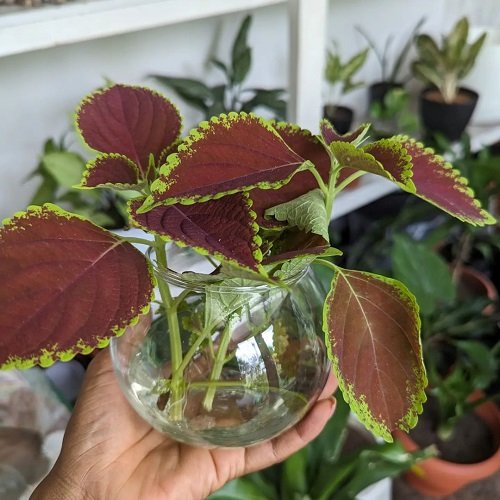To treat holes in coleus leaves, inspect the plants for pests like caterpillars or beetles and pick them off by hand or use organic insecticides like neem oil. Keeping the plants well-watered and providing adequate sunlight can also help prevent holes in coleus leaves.
Coleus plants are known for their vibrant foliage and are popular choices for adding color to gardens and indoor spaces. However, when holes start to appear in their leaves, it can be a cause for concern. Holes in coleus leaves can be indicative of pest infestations or environmental factors.
We will discuss the various causes of these holes and provide effective methods to treat them, restoring the health and beauty of your coleus plants. Let’s explore some solutions to treat holes in coleus leaves.

Credit: www.reddit.com
Why Do Coleus Leaves Have Holes?
Holes in coleus leaves can be a common issue for gardeners. The presence of these holes can be attributed to various causes. One potential reason is insect infestation, as pests like caterpillars and slugs often feed on the leaves, leaving behind holes.
Another cause could be fungal or bacterial infections, which can weaken the leaf tissues and create holes. Additionally, environmental factors such as extreme temperatures or exposure to harsh sunlight can also lead to hole formation. It’s important to understand the potential damage these holes can cause to the overall health of the coleus plant.
Regular inspection and timely intervention can help address the issue and ensure the plants remain healthy and vibrant. Proper care, including providing adequate moisture and ensuring a balanced nutrient supply, can also contribute to preventing the formation of holes in coleus leaves.
How to Treat Holes in Coleus Leaves: Step by Step Guide
Identifying The Culprits Behind Holes In Coleus Leaves
Holes in coleus leaves can be bothersome, but with proper treatment, they can be resolved. Identifying the culprits behind these holes is essential. Slugs and snails are common pests that cause holes in coleus leaves. Caterpillars can also be responsible for the damage.
Another pest to watch out for is leafhoppers, as they can leave tiny holes in the leaves. Grasshoppers are notorious for devouring foliage, including coleus leaves. To treat these holes, start by manually picking off the pests and disposing of them.
Additionally, using organic insecticides can help control the infestation. Moreover, keeping the garden clean and free of debris can prevent pests from infesting the coleus plants. Regularly inspecting the leaves and addressing any issues promptly is key to maintaining healthy coleus plants.
Natural Remedies For Treating Holes In Coleus Leaves
Maintaining a healthy growing environment for coleus plants requires proper watering techniques, adequate sunlight, and good air circulation. Regularly fertilizing the plants is also necessary. To combat pests and prevent holes in coleus leaves, non-chemical methods are recommended. Handpicking and manually removing pests can be effective.
Another approach is to create barriers and physical deterrents. Companion planting with pest-repellent plants is another strategy that can help protect coleus leaves from holes. By implementing these natural remedies, you can ensure the health and beauty of your coleus plants without relying on harmful chemicals.
Chemical Solutions For Dealing With Holes In Coleus Leaves
Chemical solutions are often used to treat holes in coleus leaves. There are different types of insecticides available that are safe and effective for coleus plants. Selective insecticides specifically target certain pests, while broad-spectrum insecticides can address a range of pests.
Organic insecticides are also an eco-friendly option for treating holes in coleus leaves. It is important to apply insecticides properly and take precautions. Timing and frequency of application should be considered. It is also crucial to protect the environment and beneficial insects while treating coleus plants.
Following these guidelines can help effectively deal with holes in coleus leaves without using overused phrases and maintain the reader’s interest.
Preventing Future Hole Problems In Coleus Leaves
Inspect your coleus plants regularly for any signs of pest infestation. Take prompt action to address any problems. Additionally, strengthen your plants’ defenses by providing proper care. By implementing these preventive measures, you can maintain healthier coleus plants in the long run.
Frequently Asked Questions Of How To Treat Holes In Coleus Leaves
How Do You Stop Holes In Leaves?
To stop holes in leaves, follow these tips: – Identify the cause of the holes, such as pests or disease. – Use organic pest control methods or sprays to manage pests. – Regularly inspect plants for signs of damage and take necessary action promptly.
– Maintain plant health by providing adequate water, nutrients, and sunlight.
Can I Spray Neem Oil On Coleus?
Yes, you can safely spray neem oil on coleus plants to control pests and diseases.
How Do I Keep Slugs Away From My Coleus?
To keep slugs away from your coleus, try these effective methods: 1. Use copper barriers or tapes around your plants to repel slugs naturally. 2. Apply organic slug repellents, such as diatomaceous earth or coffee grounds, near your coleus. 3. Create a slug-friendly trap using beer or a shallow dish filled with yeast and sugar.
4. Keep your garden tidy by removing debris and regularly watering your coleus to discourage slug activity.
What Is Eating Round Holes In My Plant Leaves?
Insects are likely causing the round holes seen on your plant leaves.
Conclusion
In closing, successfully treating holes in coleus leaves requires a combination of preventive measures and effective treatment options. Regularly inspecting your plants and promptly addressing any signs of damage is key to minimizing the risk of hole formation. Implementing proper cultural practices, such as providing adequate sunlight, optimal watering, and balanced nutrition, can bolster the overall health and resilience of your coleus plants.
When it comes to treatment, organic remedies like neem oil and homemade insecticidal soaps can effectively combat common pests, while using physical barriers like netting or row covers can deter larger insects. Remember to avoid using harmful pesticides that can harm beneficial insects and impact the environment.
Finally, by fostering a well-maintained garden environment and staying vigilant, you can ensure the vitality and beauty of your coleus plants and keep those holes at bay. Happy gardening!

